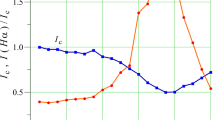Abstract
This paper investigates the physical state of the photosphere in the main phase of the two-ribbon solar flare on June 3, 1979. The derived models show that the photosphere was in a disturbed state for a long time during the main phase of the flare. In the models, the temperature in the upper photospheric layers is higher and that in the lower layers is lower than in the quiet-sun model atmosphere. During the flare, the heating extends to the lower photospheric layers, and the upper layers cool down. A comparison of the obtained models to those for the two-ribbon solar flare on October 7, 1979, shows that the height distributions of the temperature in the main phase of the flares are strongly different.
Similar content being viewed by others
References
K. V. Alikaeva, E. A. Baranovskii, and N. N. Kondrashova, “Time Changes of Chromospheric and Photospheric Matter State in Flare Loop Structure,” in Proceedings of the 7th Symposium on Solar-Earth Physics in Russia and CIS Countries, Troitsk, 1999 (IZMIRAN, Troitsk, 1999), pp. 28–34.
K. V. Alikaeva, E. A. Baranovskii, N. N. Kondrashova, et al., “Semiempirical Photospheric Models of Solar Activity Complex,” Kinem. Fiz. Nebes. Tel 11(2), 11–24 (1994).
K. V. Alikaeva and N. N. Kondrashova, “Photospheric Model Transformation in the Course of a Solar Two-Ribbon Flare,” Kinem. Fiz. Nebesn. Tel 22(3), 163–172 (2006).
A. S. Gadun and V. A. Sheminova, SRANSAT: Calculation Program of Profiles of Spectral Absorbtion Lines in Stellar Atmospheric in LTE Approach (Kiev, 1988) [in Russian].
E. A. Gurtovenko and R. I. Kostyk, Fraunhofer Spectrum and System of Solar Oscillator Strengths (Naukova Dumka, Kiev, 1989) [in Russian].
N. N. Kondrashova, “Izmenenie of Line Asymmetry during Solar Flare 7 Oct. 1979,” Kinem. Fiz. Nebes. Tel 4(4), 23–28 (1988).
N. N. Kondrashova and E. G. Rudnikova, “Spectral Investigation of a Two Ribbon Solar Flare. I. Profiles and Asymmetry of Lines,” Kinem. Fiz. Nebes. Tel 29(2), 97–106 (2003).
N. N. Kondrashova, E. G. Rudnikova, and M. N. Pasechnik, “Motions of Chromospheric and Photospheric Material in a Two Ribbon Solar Flare,” Kinem. Fiz. Nebes. Tel 17(6), 485–495 (2001).
J. M. Beckers, “A Table of Zeeman Multiplets,” Phys. Sci. Res. Papers, No. 371 (1969).
A. Berlicki, P. Heinzel, B. Schmieder, et al., “Non-LTE Diagnostics of Velocity Fields during the Gradual Phase of a Solar Flare,” Astron. Astrophys. 430, 679–689 (2005).
P. J. Cargill and E. R. Priest, “The Heating of Postflare Loops,” Astrophys. J. 266, 383–389 (1983).
A. Czaykowska, D. Alexander, and B. De Pontieu, “Chromospheric Heating in the Late Phase of Two-Ribbon Flares,” Astrophys. J. 552, 849–857 (2001).
G. A. Doschek, J. P. Boris, C.-C. Cheng, et al., “A Numerical Simulation of Cooling Coronal Flare Plasma,” Astrophys. J. 258, 373–383 (1982).
A. Falchi, R. Galciani, and L. A. Smaldone, “Abalysis of the Optical Spectra of the Solar Flare. VI. Velocity Field in the 13 June 1980 Flare Area,” Astron. Astrophys. 256, 255–263 (1992).
A. Falchi, J. Qiu, and G. Cauzzi, “Chromospheric Evidence for Magnetic Reconnection,” Astron. Astrophys. 328, 371–380 (1997).
W. Q. Gan and C. Fang, “Timep-Match Semi-Empirical Models of the Chromospheric Flare on 3 February, 1983,” Solar Phys. 107, 311–321 (1987).
W. Q. Gan and C. Ganf, “A Hydrodynamic Model of the Gradual Phase of the Solar Flare Loop,” Astrophys. J. 358, 328–337 (1990).
P. Gingerich, R. W. Noyes, W. Kalkofen, and Y. Cuny, “The Harvard-Smithsonian Reference Atmosphere,” Solar Phys. 18, 347–365 (1971).
R. A. Kopp and G. W. Pneuman, “Magnetic Reconnection in the Corona and the Loop Prominence Phenomenon,” Solar Phys. 50, 85–98 (1976).
E. V. Kurochka, V. G. Lozitsky, and O. B. Osyka, “Temporal Changes of Physical Conditions in the Photospheric Layers of a Solar Frale,” Kinem. Phys. Cel. Bodies 24, 215–222 (2008).
M. E. Machado, E. H. Avrett, J. E. Vernazza, and R. W. Noyes, “Semiempirical Models of Chromospheric Flare Regions,” Astrophys. J. 242, 336–351 (1980).
M. E. Machado and J. L. Linsky, “Flare Model Chromospheres and Photospheres,” Solar Phys. 42, 395–420 (1975).
C. E. Moore, M. G. J. Minnaert, and J. Houtgast, The Solar Spectrum 2935 to 8770 A (National Bureau of Standards, Washington, DC, 1966).
F. Nagai, “A Model of Hot Loops Associated with Solar Flares. I. Gasdynamics in the Loops,” Solar Phys. 68, 351–379 (1980).
C. B. Ruiz and I. J. C. del Toro, “Inversion of Stokdes Profiles,” Astrophys. J. 398, 375–385 (1992).
B. Schmieder, T. G. Forbes, J. M. Malherbe, and M. E. Machado, “Evidence for Gentle Chromospheric Evaporation During the Gradual Phase of Large Solar Flare,” Astrophys. J. 317, 956–963 (1987).
Solar Geophys. Data 431(Pt. 2), 37 (1980).
Z. Svestka, “Cooling of a Coronal Flare Loop Through Radiation and Conduction,” Solar Phys. 108(2), 411–414 (1987).
Z. Svestka, “Solar Flares — The Gradual Phase,” Solar Phys. 121, 399–417 (1980).
J. E. Vernazza, E. H. Avrett, and R. Loeser, “Structure of the Solar Chromosphere. III. Models of the EUV Brightness Components of the Quiet Sun,” Astrophys. J. Suppl. Ser. 45, 635–725 (1981).
Author information
Authors and Affiliations
Corresponding author
Additional information
Original Russian Text © N.N. Kondrashova, 2011, published in Kinematika i Fizika Nebesnykh Tel, 2011, Vol. 27, No. 2, pp. 43–52.
About this article
Cite this article
Kondrashova, N.N. Lower atmosphere in the main phase of a two-ribbon solar flare. Kinemat. Phys. Celest. Bodies 27, 86–91 (2011). https://doi.org/10.3103/S0884591311020061
Received:
Published:
Issue Date:
DOI: https://doi.org/10.3103/S0884591311020061



